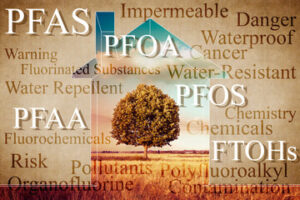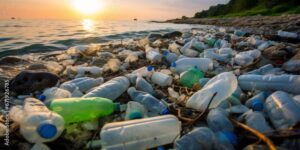What is PFAS?
PFAS, or per- and polyfluoroalkyl substances, are a group of human-made chemicals that have been widely used in various industrial and consumer products since the 1940s. These chemicals are often referred to as “forever chemicals” due to their persistence in the environment and the human body; they do not break down easily and can accumulate over time.
PFAS are commonly found in:
- Non-stick cookware (e.g., Teflon)
- Water-repellent clothing and gear
- Food packaging materials
- Firefighting foams
- Industrial processes

Why are PFAS a Concern?
The widespread use and persistence of PFAS have led to contamination of soil, water, and air, as well as human and animal exposure. Studies have linked PFAS exposure to various health risks, including:
- Hormonal disruptions
- Immune system effects
- Increased cholesterol levels
- Developmental issues in infants and children
- Some cancers (e.g., kidney and testicular)
How to Get the Best Water for Your Home or Business With Jeanne Carton – 02.29.2024 (youtube.com)

Drinking Water Standards for PFAS
Current Standards and Guidelines
Regulating PFAS in drinking water is complex due to the large number of different PFAS compounds and their varying toxicities. However, several governments and agencies have developed guidelines and standards to ensure safe drinking water:
- United States Environmental Protection Agency (EPA):
- The EPA has established a health advisory level for two of the most studied PFAS compounds, PFOA and PFOS, at 70 parts per trillion (ppt) individually or combined in drinking water. This advisory level is not enforceable but provides guidelines for assessing potential health risks.
- European Union:
- The European Commission has set a limit of 0.1 µg/L (100 ppt) for individual PFAS and 0.5 µg/L (500 ppt) for the sum of all PFAS in drinking water.
- Other Countries:
- Different countries have established their own guidelines and standards, often based on local conditions and research. For example, Australia has set a guideline value of 0.07 µg/L (70 ppt) for PFOA and 0.56 µg/L (560 ppt) for PFOS in drinking water.
Future Regulations

As research continues and our understanding of PFAS toxicity improves, it is expected that regulations will become more stringent. Some states in the U.S. have already moved forward with their own, stricter regulations:
- New Jersey: Set maximum contaminant levels (MCLs) at 14 ppt for PFOA and 13 ppt for PFOS.
- Vermont: Adopted an MCL of 20 ppt for five combined PFAS compounds (PFOA, PFOS, PFHxS, PFHpA, and PFNA).
Ensuring Safe Drinking Water
Testing and Monitoring
Regular testing and monitoring of drinking water sources for PFAS is crucial for ensuring water safety. Public water systems are increasingly required to test for PFAS and report the results to regulatory authorities and the public.
Treatment Options
If PFAS contamination is detected, several treatment technologies can be employed to remove these chemicals from drinking water:
- Activated Carbon Filtration: Effective at absorbing PFAS molecules and removing them from water.
- Ion Exchange Resins: Exchange ions in water with ions fixed to resins, capturing PFAS in the process.
- Reverse Osmosis: Uses a semipermeable membrane to remove a wide range of contaminants, including PFAS.
Personal Precautions
Individuals can also take steps to reduce their exposure to PFAS:
- Use home water filtration systems certified to remove PFAS.
- Avoid using products known to contain PFAS, such as certain non-stick cookware and water-repellent fabrics.
- Stay informed about local water quality reports and any advisories issued by health authorities.
Conclusion
PFAS contamination is a significant environmental and public health issue. Understanding the drinking water standards for PFAS, staying informed about regulatory updates, and taking proactive measures can help ensure access to safe water. As research advances, we anticipate continued efforts to mitigate the risks associated with these persistent and pervasive chemicals.
For more detailed information on the current guidelines and how to safeguard your water, reach out to your local water authority or health department.
For Tons of Great Free Information please hit “Like & Subscribe”
Websiteconstructionconsumeradvocacyinstitute.com
Podcastanchor.fm/galloway

